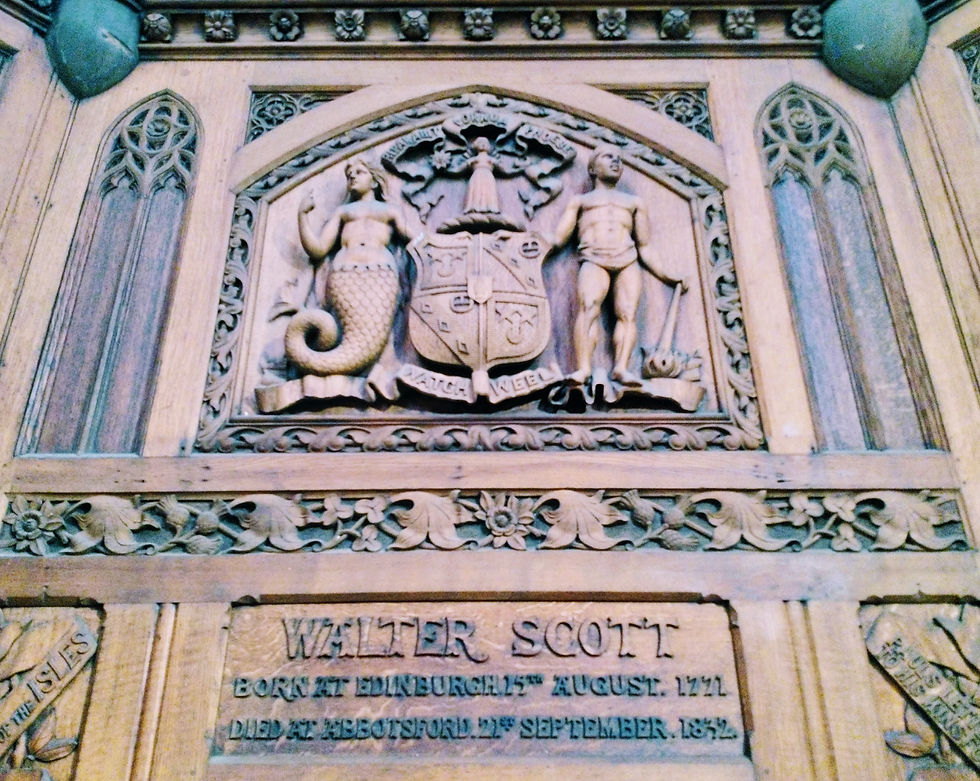The Scott Monument: Honouring a Legend
- Wee Walking Tours

- Sep 30, 2019
- 4 min read
Updated: Jan 16, 2023
“Piled deep and massy, close and high; Mine own romantic town.”- Sir Walter Scott

This week, we finish our mini-series on Sir Walter Scott with our third instalment, and it only seemed fitting to end in Scott's hometown. In this post, I discuss the iconic Edinburgh structure- the Scott Monument. Sir Walter Scott has been remembered in many ways, but the monument dedicated to him in Princes Street Gardens, is one that appropriately honours him for the Scottish superstar that he was and is.

As most locals do, we go by the Monument daily. However, this past July, we decided to do a proper visit of it as we had family visiting. Therefore, all the pictures from inside and up on the observation levels are from that day as well as some shots taken of the base. The rest of the pictures are from throughout the year and whenever we felt inspired to take pictures of the glorious structure. I hope you enjoy this brief look at the history of the monument, some architectural details, and, most of all, the pictures celebrating our 'Gothic Rocket'.
Unlikely Winner
After his death in 1832, people were demanding that Sir Walter Scott be properly honoured in the city of his birth. In true Scottish fashion, and perhaps as if Scott had written it himself, the story behind how the monument came to be is quite a tale to be told.
In 1836, a competition was announced for a design of a monument. A little-known carpenter entered the competition but used the alias, 'John Morvo'. Morvo was the name of a master stone mason from the 16th century that worked on Melrose Abbey in the Scottish Borders. The man masking his identity was George Kemp, a self-taught architect. Apparently, Kemp didn't think it wise to use his own name because he didn't have proper architectural qualifications as did other competition entrants. It isn't surprising that he would use the name of a Melrose Abbey mason as he had studied the Abbey and even exhibited some of his drawings of it at the Scottish Academy.

Initially, the competition committee chose Rickman and Hutchinson- an English architectural firm- as the first-place winners. However, there was some disagreement among the committee, and they called for a second round of drawing submissions. At some point before this second round, Kemp's identity was revealed. Therefore, Kemp entered the second round of competition under his own name and revised his original drawings. This time, the committee awarded Kemp the winner as they were attracted to his Gothic, medieval aesthetic and overall design.
Construction of the Monument began in 1841. Unfortunately, there is a sad twist of fate as Kemp didn't see his monument finished. He tragically died in 1844 when he was walking home one evening; he fell in the Union Canal and drowned. Fittingly, he is buried in St. Cuthbert's kirkyard which overlooks Princes Street Gardens and the Scott Monument.

Monument Details
The Scott Monument was inaugurated in 1846. True to Kemp's passion for medieval architecture, it is a beautiful ode to Gothic design. It stands over 61 meters (200 1/2 ft.) high and has 68 statues in niches around the monument, many represent various characters from Scott's stories. A marble statue of Sir Walter Scott is featured at the base of the monument and was carved by Sir John Steell. Scott's beloved dog, Maida, is by his side. We find this particular aspect quite touching as we have two dogs who are part of our family- including Sawyer who is the Golden Retriever tour guide of our Edinburgh walking tours.


The Scott Monument is part of the Museums and Galleries of Edinburgh family. You can go inside and climb up the monument, but admission is by guided tour only. Visit the Monument's website for more information on how to plan your visit. Also, make sure to stop by the Museums and Galleries of Edinburgh's other site, The Writers' Museum. There, you can find more information on Sir Walter Scott including a scale model of the Monument.
Of particular note on the Scott Monument tour is the Museum Room on the first floor. This room alone is well worth the small admission fee to get inside the Monument. The small area has four beautiful stained-glass windows that feature Saints Andrew and Giles as well as the coat of arms for the city of Edinburgh and of Scotland. The Museum room also has important information on Scott's life and the building of the Monument.


As you continue your climb up the Monument, you make stops at two more levels (though not the very top as that is closed off to visitors for safety reasons) which afford fantastic 360-degree views of Edinburgh. It can be quite windy- so make sure to hold onto your phone or camera tightly when taking pictures! Do take the time to not only appreciate the views of the city, but also the incredible Monument itself. It is full of fascinating carvings and details just waiting to be found.



Well, that brings our three-part miniseries on Sir Walter Scott to an end. I hope you enjoyed our celebration of Scott's life at Abbotsford, as well as when we paid our respects at his burial place in Dryburgh Abbey, and now honouring his memory in Edinburgh with one of the largest monuments ever created for a writer. However, don't fear dear reader, as I will be sure to continue to honour Sir Walter Scott in the future in this blog. After all, he is a Scottish legend.
Until next time- Explore & Discover!



